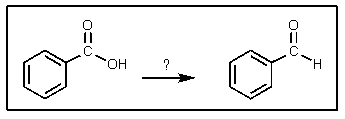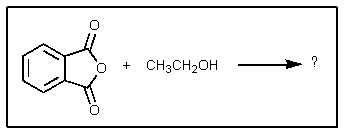A) ![]()
B) ![]()
C) ![]()
D) two of these
E) all of these
G) B) and C)
Correct Answer

verified
Correct Answer
verified
Multiple Choice
What would be the product of the following reaction? 
A) ![]()
B) ![]()
C) ![]()
D) ![]()
E) None of these.
G) B) and D)
Correct Answer

verified
Correct Answer
verified
Multiple Choice
Predict the product of the following reaction: 
A) ![]()
B) ![]()
C) ![]()
D) ![]()
E) no reaction occurs
G) A) and C)
Correct Answer

verified
Correct Answer
verified
Multiple Choice
What would be the major organic product expected from the following reaction? 
A) ![]()
B) ![]()
C) ![]()
D) ![]()
E) ![]()
G) A) and B)
Correct Answer

verified
Correct Answer
verified
Multiple Choice
Which of the following reactions will not give a carboxylic acid as a product?
A) ![]()
B) ![]()
C) ![]()
D) ![]()
E) ![]()
G) B) and E)
Correct Answer

verified
Correct Answer
verified
Multiple Choice
What would be the major organic product of the following reaction? 
A) ![]()
B) ![]()
C) ![]()
D) ![]()
E) ![]()
G) A) and B)
Correct Answer

verified
Correct Answer
verified
Multiple Choice
A multistep preparation of propylpropanoate from only 1-propanol would require the use of how many of the reagents below (i.e.,what reagents would you need to use if you only had 1-propanol to start with) ? 

A) Two of the above.
B) Three of the above.
C) Four of the above.
D) All of the above.
E) The preparation cannot be done with only these reagents.
G) A) and D)
Correct Answer

verified
Correct Answer
verified
Multiple Choice
Which of the following is a lactam?
A) ![]()
B) ![]()
C) ![]()
D) ![]()
E) Two of these can be considered lactams.
G) C) and E)
Correct Answer

verified
C
Correct Answer
verified
Multiple Choice
Which reagent(s) would accomplish the following transformation? 
A) CH3Li
B) CH3I,NaOH
C) CH3MgBr
D) (CH3) 2CuLi
E) either A or C
G) A) and C)
Correct Answer

verified
Correct Answer
verified
Multiple Choice
What would be the organic product of the following reaction? 
A) ![]()
B) ![]()
C) ![]()
D) ![]()
E) None of these.
G) B) and D)
Correct Answer

verified
Correct Answer
verified
Multiple Choice
Reduction of which of the following esters with lithium aluminum hydride would yield two molecules of the same alcohol?
A) ![]()
B) ![]()
C) ![]()
D) ![]()
E) None of these.
G) B) and C)
Correct Answer

verified
Correct Answer
verified
Multiple Choice
What type of functional group do the natural products known as waxes have?
A) Ester
B) Amide
C) Carboxylic acid
D) Alcohol
E) Amine
G) A) and B)
Correct Answer

verified
A
Correct Answer
verified
Multiple Choice
What reagent(s) would be required to achieve the following conversion? 
A) ![]()
B) ![]()
C) ![]()
D) ![]()
E) both A and C
G) A) and B)
Correct Answer

verified
Correct Answer
verified
Multiple Choice
What is the product of combining pentanoic acid with thionyl chloride,followed by propanol and base?
A) pentanol
B) pentyl propanoate
C) propyl pentanoate
D) 1-tosyl pentanol
E) 1-chloropentanol
G) D) and E)
Correct Answer

verified
Correct Answer
verified
Multiple Choice
The product of the following reaction would be: 
A) ![]()
B) ![]()
C) ![]()
D) ![]()
E) ![]()
G) A) and C)
Correct Answer

verified
Correct Answer
verified
Multiple Choice
Which of the following would be properly named as 2-chloroethyl benzoate?
A) ![]()
B) ![]()
C) ![]()
D) ![]()
E) ![]()
G) None of the above
Correct Answer

verified
Correct Answer
verified
Multiple Choice
When compound X is heated with aqueous acid,acetic acid and acetaldehyde (ethanal) are formed.The proton NMR spectrum of X is shown below.What is the structure of X? 
A) CH2=CHO2CCH3
B) CH2=CHOCH2CH3
C) CH2=C(CH3) O2CH
D) CH3CH=CHO2CH
E) CH2=CHCH2CO2H
G) A) and E)
Correct Answer

verified
Correct Answer
verified
Multiple Choice
Which of the following reactions will produce N-methyl benzamide?
A) ![]()
B) ![]()
C) ![]()
D) both A and C
E) All of the above.
G) C) and D)
Correct Answer

verified
Correct Answer
verified
Multiple Choice
What is the product from the following reaction? 
A) ![]()
B) ![]()
C) ![]()
D) ![]()
E) ![]()
G) A) and E)
Correct Answer

verified
Correct Answer
verified
Multiple Choice
What reagent is needed to complete the reaction shown? 
A) ((CH3) 2CH) 2CuLi
B) KCN/NaOH
C) HOCH(CH3) 2
D) BrMgCH(CH3) 2
E) (CH3) 2CHLi
G) A) and C)
Correct Answer

verified
A
Correct Answer
verified
Showing 1 - 20 of 44
Related Exams